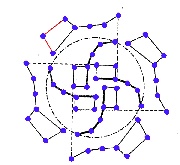The dragon, the winged serpent, is the most widespread mythological beast in the world. Dragons appear in Old World myths from Europe, India, the Middle East, Asia, Southeast Asia, and the South Pacific, as well in the New World in the form of the feathered serpent from Indian tribes in North America and Olmec, Maya, and Aztec cultures from Mesoamerica. Dragons have been represented on the gates of Babylon, Chinese vases, pictographs above the Mississippi River, and bones carved by Inuit artists in the Arctic.
The oldest versions were snakes, but after the Middle Ages, dragons were often pictured with legs, either stubby reptilian legs or sturdy avian or feline legs, usually two or four. Most have one head, though some have two or even three. Most are associated with bodies of water and rainfall.
Where did this image of the flying snake come from? In The First Fossil Hunters, Adrienne Mayor suggests that fossils of dinosaurs such as Archaeopteryx or skeletons of whales spawned the legend. Others suggest crocodiles, giant goannas (in Australia), or the Komodo lizard (in Japan). Anthropologist David E. Jones suggests that dragons were the sum of ancient people’s fears: snakes, birds of prey, and big cats.
All of those arguments may have some merit, but none explain the universality of the image. I think the people saw the winged serpent in the stars, specifically, in the combination of Ursa Major and Draco.
The Big Dipper
One of the most familiar asterisms in the night sky is the Big Dipper, part of the constellation Ursa Major. It’s easy to find because the stars are so bright.
For many, the seven bright stars look like the outline of a giant ladle or dipper, but other people see the seven bright stars of the Big Dipper as a plough, a wagon drawn by oxen or a carriage drawn by horses, a camel, a skunk, a fisher cat, a salmon net, a butcher’s cleaver, a coffin with three mourners following behind, a saucepan, or a basket. In some places, the seven stars represented people, such as the Seven Sages or Seven Brothers.
Many northern peoples saw the Big Dipper as a giant bear, a mother bear being followed by three cubs, or a bear being chased by three hunters. The bear image itself is subject to debate. Some see the Big Dipper as fitting in the bear’s back while others make the handle of the Dipper into a very long tail, which is strange since bears have such stumpy little tails, though the problem is often explained away with a story.
Let’s look at it a different way: take the Big Dipper as the body and wing of a great bird instead. Add the other wing from the bright stars already included as part of the Great Bear constellation that you can see in the illustration. Then you’ll have the body and both wings of the bird. The tail comes out at the bottom of the bird’s body, and the head comes from stars not included in the constellation grouping.
Always Circling the Center
The Big Dipper is a circumpolar asterism, meaning it rotates around the unmoving center of the night sky, which we now call Polaris, or the Pole Star, in the course of the night. It also marks the seasons, in that it rises in different positions at twilight during winter, spring, summer, and fall. It would be easy for ancient people to tell what time it was at night by the position of the Dipper, and to know the seasons from the Dipper’s position at dusk.
When you consider all the seasonal positions of the Big Dipper and Little Dipper, you get a whirling pattern like the one in the diagram.
Draco the Dragon
The other half of the dragon is Draco, the constellation that snakes around between the Big Dipper and the Little Dipper. While Polaris is currently the closest star to true North in the night sky, 5,000 years ago it was Thuban, one of the stars in Draco. Farther back yet, it was the dark space between the stars referred to as the Cave of Creation.
In North America, many images of the whirling logs or swastika design appear to incorporate the movements of the Dipper. Some include both the winged figure and the serpent.
This piece shows the whirling pattern incorporating both horned rattlesnakes and winged figures with feline heads, combining forces of the earth and sky. As far back as 1901, Zelia Nuttall recognized the role of the Big Dipper in the whirling logs or swastika design so common in American Indian artifacts. The review of her article “The Fundamental Principles of New and Old World Civilizations” from the Archaeological and Ethnological Papers of the Peabody Museum of Harvard University, notes that Ms. Nuttall suggested that the swastika symbol was “believed to have originated in the revolution of the stars of Ursa Major about Polaris….” In fact, she suggests that the swastika itself is merely a representation of the Big Dipper at all four seasons.
If indeed, the Big Dipper is part of a great Celestial Bird, the Bird and the Serpent together wheel around the Portal of Heaven, the Cave of Creation. Their power as opposites is combined into the force that moves the heavens. They become the Winged Serpent, the Feathered Serpent, the place where earth and sky, male and female join to generate the force that moves the heavens.
This is the image I use for the Misfits and Heroes series of ancient adventure novels. It’s my own drawing based on the current positions of the stars in Ursa Major and Draco, designed to be a symbol of the dynamic opposites so important to the ancients, especially in Mesoamerica. It’s a dragon, or at least its parts, momentarily and somewhat artificially suspended in time and motion in its endless circle around the Portal of Creation.















